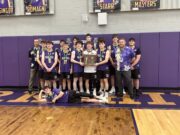Garrettsville – Over the 43-year tenure of social studies teacher Iva Walker, every student attending James A. Garfield Schools learned about the last great American train heist involving Alvin “Creepy” Karpis and his gang of Depression-era gangsters. It was all part of Ms. Walker’s desire to unveil local history and show how its effects ripple through to the present day. Julie Thompson was one student who took this lesson to heart. Now Thompson is the author of a newly-released book, The Hunt for the Last Public Enemy in Northeastern Ohio: Alvin “Creepy” Karpis and his Road to Alcatraz. She will hold a public book-signing at the James A. Garfield Historical Society in historic downtown Garrettsville on Saturday, May 4, 4-6 p.m.
The book was released nationally on April 15. During the May 4 signing, Thompson will read excerpts from her book and the Society will have books available at $2 off the retail price of $21.99. Another book signing will take place at the Village Bookstore later in June. Thompson will be host at an event at Alcatraz Island, as well. In addition to the 50 discounted books available at the Historical Society signing, they can be purchased from the Village Bookstore in Garrettsville, or online through The History Press at www.arcadiapublishing.com/Products/9781467138208.
JAG Historical Society President Debbie Smith recalls that Thompson, a former volunteer, “started this research project in our Bonnet Shoppe, and now it has hit national recognition! She single-handedly achieved getting a State Historical Marker which our town benefits from, and has published a book which includes some of our town’s history, which we support and preserve.“
Still a resident of Freedom Township, Julie enjoys sharing this story “to tell those out-of-towners when they ask whether anything exciting ever happens in this neck of the woods, ‘This is a real crime story, taking place in my hometown,’” she likes to say. “To this stealthy thief known as “Creepy” Karpis, Garrettsville proved to be an easy score. Regardless of the many decades that have passed, people here and everywhere remain very interested in the lore of gangsters, drawn to the idea of that era.”

Thompson completed her history degree at Hiram College (’13), where she used her capstone research project – the story of the Great Train Robbery in Garrettsville – to secure two major grants and a state historical marker (2014) on Freedom Street at the site of the former train depot along the Headwaters Hike-and-Bike Trail.
For her senior capstone, Thompson says that she “wanted to investigate something especially unique, and a topic that had likely been overlooked in history. I landed on this local historical topic after watching the 2009 crime drama Public Enemies and starring Johnny Depp as John Dillinger. During a particular scene depicting George “Machine-Gun” Kelly’s 1933 capture (an infamous bank robber), I experienced a sort of déjà vu when seeing the word “G-Men” written over the concrete walls of Kelly’s apartment. I was immediately taken back three decades earlier when my social studies teacher, Iva Walker, mentioned a local train robbery and the folklore of the Garfield G-Men mascot during a seventh-grade class discussion.
“This crime took place just three miles from my own backyard, and I immediately recognized that this story had to be much bigger than had been previously recognized by folks in our communities throughout the decades. So, I rolled up my sleeves for the long haul.”
As part of her background in historical research, Thompson has volunteered at the U.S. Holocaust Memorial Museum and has worked with the Library of Congress Publishing Office. She is an active member of the Freedom Township Historical Society and has served on the board of trustees for the James A. Garfield Historical Society, where she engaged with Hiram College to develop the society’s first internship program and served as a member of her area’s Inter-Museum Council.
Thompson explains that Karpis’ 1935 train robbery in Garrettsville relates to the first arrest made by new FBI director J. Edgar Hoover, which launched him and his G-Men into national prominence and helped secure the JAG school mascot name as the G-Men. FBI agents known as Government Men (G-Men) were sent to the Garrettsville area to search for Karpis and his accomplices following the train caper. The enduring “fighting G-Men” mascot, characterized by an inspector wearing a deerstalker-style cap and holding a magnifying glass, represents the Government Men who flooded this area following the train heist.
The back cover of Thompson’s book relates, “The last Public Enemy No. 1 of the Depression era, Alvin “Creepy” Karpis reportedly compiled a record of fifty-four aliases, fifteen bank robberies, fourteen murders, three jailbreaks and two kidnappings. Roaming the country to evade capture (or worse), Karpis regularly hid out in northeastern Ohio, where he and the remnants of the infamous Ma Barker Gang perpetrated the last great American train heist in Garrettsville. His criminal career came to an end when J. Edgar Hoover and his famed G-Men apprehended the man they wanted more than any other in New Orleans From there, Karpis found himself confined on Alcatraz Island, where he spent nearly twenty-six years—more than any other inmate in the prison’s history. Historian Julie Thompson tells the true story of Karpis’s life and career, a riveting tale taking readers from rural Kansas and Ohio to the bustling streets of the Big Easy and into the bleak innards of ‘the Rock.’”
During Thompson’s research, she says that she continually ran across erroneous information about the life and criminal career of Alvin Karpis. She wanted to portray him accurately, “not as the larger-than-life, charismatic criminal whom Americans could cheer on like they did John Dillinger or Pretty Boy Floyd. Rather, this plain Kansas boy was a timid and quiet little man recognized for his dapper style. Karpis’s cunning and dangerous demeanor was hidden behind his sinister smile and those cold blue eyes. Karpis remained the creative driving force behind the gang’s crime spree.”
Thompson also wanted to set the record straight about Hoover. “Americans considered J. Edgar Hoover the hero. He made the G-Man brand so popular that it was harder to become an FBI agent than to be accepted into an Ivy League college. Hoover and his G-Men achieved powerful influence for the FBI and defined this federal agency as the protector of national security for our country’s future. Despite Hoover’s towering reputation, the top G-Man was not without reproach. Hoover was an egomaniac who became tyrannical, ruling the FBI as his personal kingdom while habitually abusing power; thus, intriguing us to ask, ‘Who was the real villain in this tug-of-war story?’”
Ultimately, Thompson says that this “last successful great train heist in American history at the Garrettsville train depot has left an indelible mark on the historic village of Garrettsville, Ohio, and the Northeastern region.”
Thompson claims that no other historian or researcher has connected Karpis’s train heist in Garrettsville to the FBI’s revival and enhancement of human-source intelligence and surveillance strategies. These surveillance and human source strategies were provided through the efforts of professional and criminal informants, witnesses, and undercover agents who provided intelligence defined by communication, problem-solving, and learning of information.
Now that her book is completed, Thompson says, “It is often said that in a small town, nothing ever happens. Brace yourself, as everything is about to change—despite the story being lived out more than 80 years ago. This is a not-so-nice true account about a criminal who became an outlaw hunted by what would become the premier law enforcement organization in the world. Thus, here lies the premise: This outlaw’s legacy is introduced with a local story that left surprising national implications.”











